Dual Kv7.2/3-TRPV1 modulators inhibit nociceptor hyperexcitability and alleviate pain without target-related side effects.
IF 5.9
1区 医学
Q1 ANESTHESIOLOGY
引用次数: 0
Abstract
Persistent or chronic pain is the primary reason people seek medical care, yet current therapies are either limited in efficacy or cause intolerable side effects. Diverse mechanisms contribute to the basic phenomena of nociceptor hyperexcitability that initiates and maintains pain. Two prominent players in the modulation of nociceptor hyperexcitability are the transient receptor potential vanilloid type 1 (TRPV1) ligand-gated ion channel and the voltage-gated potassium channel, Kv7.2/3, that reciprocally regulate neuronal excitability. Across many drug development programs targeting either TRPV1 or Kv7.2/3, significant evidence has been accumulated to support these as highly relevant targets; however, side effects that are poorly separated from efficacy have limited the successful clinical translation of numerous Kv7.2/3 and TRPV1 drug development programs. We report here the pharmacological profile of 3 structurally related small molecule analogues that demonstrate a novel mechanism of action (MOA) of dual modulation of Kv7.2/3 and TRPV1. Specifically, these compounds simultaneously activate Kv7.2/3 and enable unexpected specific and potent inhibition of TRPV1. This in vitro potency translated to significant analgesia in vivo in several animal models of acute and chronic pain. Importantly, this specific MOA is not associated with any previously described Kv7.2/3 or TRPV1 class-specific side effects. We suggest that the therapeutic potential of this MOA is derived from the selective and specific targeting of a subpopulation of nociceptors found in rodents and humans. This efficacy and safety profile supports the advancement of dual TRPV1-Kv7.2/3 modulating compounds into preclinical and clinical development for the treatment of chronic pain.双重 Kv7.2/3-TRPV1 调节剂可抑制痛觉感受器过度兴奋并减轻疼痛,同时不会产生与靶点相关的副作用。
持续或慢性疼痛是人们就医的主要原因,但目前的疗法要么疗效有限,要么会产生难以忍受的副作用。引起和维持疼痛的痛觉感受器过度兴奋这一基本现象是由多种机制造成的。调节痛觉感受器过度兴奋性的两个主要角色是瞬时受体电位香草素 1 型(TRPV1)配体门控离子通道和电压门控钾通道 Kv7.2/3,它们相互调节神经元的兴奋性。在许多以 TRPV1 或 Kv7.2/3 为靶点的药物开发项目中,已经积累了大量证据来支持这些高度相关的靶点;然而,由于副作用与疗效分离不清,限制了许多 Kv7.2/3 和 TRPV1 药物开发项目的成功临床转化。我们在此报告了 3 种结构相关的小分子类似物的药理学特征,它们展示了 Kv7.2/3 和 TRPV1 双重调节的新型作用机制 (MOA)。具体来说,这些化合物能同时激活 Kv7.2/3,并对 TRPV1 起到意想不到的特异性强效抑制作用。这种体外效用在几种急性和慢性疼痛动物模型中转化为体内显著的镇痛效果。重要的是,这种特异性 MOA 与之前描述的 Kv7.2/3 或 TRPV1 类特异性副作用无关。我们认为,这种 MOA 的治疗潜力来自于对啮齿动物和人类痛觉感受器亚群的选择性和特异性靶向作用。这种疗效和安全性支持将双 TRPV1-Kv7.2/3 调节化合物推进到临床前和临床开发中,用于治疗慢性疼痛。
本文章由计算机程序翻译,如有差异,请以英文原文为准。
求助全文
约1分钟内获得全文
求助全文
来源期刊

PAIN®
医学-临床神经学
CiteScore
12.50
自引率
8.10%
发文量
242
审稿时长
9 months
期刊介绍:
PAIN® is the official publication of the International Association for the Study of Pain and publishes original research on the nature,mechanisms and treatment of pain.PAIN® provides a forum for the dissemination of research in the basic and clinical sciences of multidisciplinary interest.
 求助内容:
求助内容: 应助结果提醒方式:
应助结果提醒方式:


